Shihao Li
Alibaba Inc
Optimization-Guided Diffusion for Interactive Scene Generation
Dec 11, 2025Abstract:Realistic and diverse multi-agent driving scenes are crucial for evaluating autonomous vehicles, but safety-critical events which are essential for this task are rare and underrepresented in driving datasets. Data-driven scene generation offers a low-cost alternative by synthesizing complex traffic behaviors from existing driving logs. However, existing models often lack controllability or yield samples that violate physical or social constraints, limiting their usability. We present OMEGA, an optimization-guided, training-free framework that enforces structural consistency and interaction awareness during diffusion-based sampling from a scene generation model. OMEGA re-anchors each reverse diffusion step via constrained optimization, steering the generation towards physically plausible and behaviorally coherent trajectories. Building on this framework, we formulate ego-attacker interactions as a game-theoretic optimization in the distribution space, approximating Nash equilibria to generate realistic, safety-critical adversarial scenarios. Experiments on nuPlan and Waymo show that OMEGA improves generation realism, consistency, and controllability, increasing the ratio of physically and behaviorally valid scenes from 32.35% to 72.27% for free exploration capabilities, and from 11% to 80% for controllability-focused generation. Our approach can also generate $5\times$ more near-collision frames with a time-to-collision under three seconds while maintaining the overall scene realism.
Natural Geometry of Robust Data Attribution: From Convex Models to Deep Networks
Dec 09, 2025Abstract:Data attribution methods identify which training examples are responsible for a model's predictions, but their sensitivity to distributional perturbations undermines practical reliability. We present a unified framework for certified robust attribution that extends from convex models to deep networks. For convex settings, we derive Wasserstein-Robust Influence Functions (W-RIF) with provable coverage guarantees. For deep networks, we demonstrate that Euclidean certification is rendered vacuous by spectral amplification -- a mechanism where the inherent ill-conditioning of deep representations inflates Lipschitz bounds by over $10{,}000\times$. This explains why standard TRAK scores, while accurate point estimates, are geometrically fragile: naive Euclidean robustness analysis yields 0\% certification. Our key contribution is the Natural Wasserstein metric, which measures perturbations in the geometry induced by the model's own feature covariance. This eliminates spectral amplification, reducing worst-case sensitivity by $76\times$ and stabilizing attribution estimates. On CIFAR-10 with ResNet-18, Natural W-TRAK certifies 68.7\% of ranking pairs compared to 0\% for Euclidean baselines -- to our knowledge, the first non-vacuous certified bounds for neural network attribution. Furthermore, we prove that the Self-Influence term arising from our analysis equals the Lipschitz constant governing attribution stability, providing theoretical grounding for leverage-based anomaly detection. Empirically, Self-Influence achieves 0.970 AUROC for label noise detection, identifying 94.1\% of corrupted labels by examining just the top 20\% of training data.
MVU-Eval: Towards Multi-Video Understanding Evaluation for Multimodal LLMs
Nov 13, 2025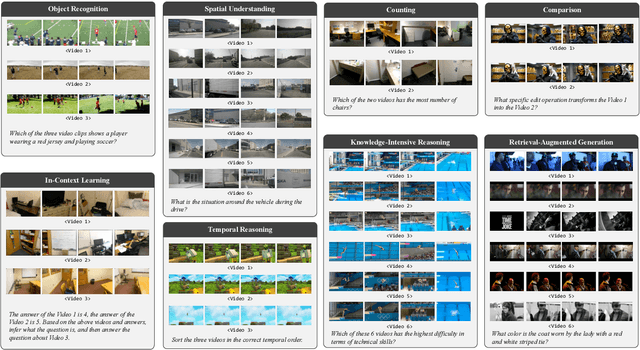

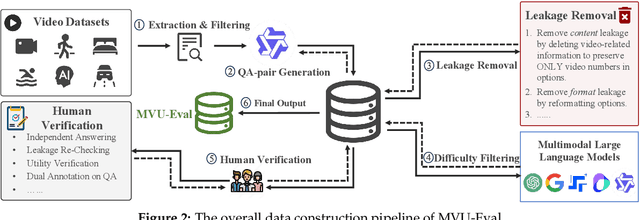

Abstract:The advent of Multimodal Large Language Models (MLLMs) has expanded AI capabilities to visual modalities, yet existing evaluation benchmarks remain limited to single-video understanding, overlooking the critical need for multi-video understanding in real-world scenarios (e.g., sports analytics and autonomous driving). To address this significant gap, we introduce MVU-Eval, the first comprehensive benchmark for evaluating Multi-Video Understanding for MLLMs. Specifically, our MVU-Eval mainly assesses eight core competencies through 1,824 meticulously curated question-answer pairs spanning 4,959 videos from diverse domains, addressing both fundamental perception tasks and high-order reasoning tasks. These capabilities are rigorously aligned with real-world applications such as multi-sensor synthesis in autonomous systems and cross-angle sports analytics. Through extensive evaluation of state-of-the-art open-source and closed-source models, we reveal significant performance discrepancies and limitations in current MLLMs' ability to perform understanding across multiple videos. The benchmark will be made publicly available to foster future research.
Algorithm-Relative Trajectory Valuation in Policy Gradient Control
Nov 11, 2025Abstract:We study how trajectory value depends on the learning algorithm in policy-gradient control. Using Trajectory Shapley in an uncertain LQR, we find a negative correlation between Persistence of Excitation (PE) and marginal value under vanilla REINFORCE ($r\approx-0.38$). We prove a variance-mediated mechanism: (i) for fixed energy, higher PE yields lower gradient variance; (ii) near saddles, higher variance increases escape probability, raising marginal contribution. When stabilized (state whitening or Fisher preconditioning), this variance channel is neutralized and information content dominates, flipping the correlation positive ($r\approx+0.29$). Hence, trajectory value is algorithm-relative. Experiments validate the mechanism and show decision-aligned scores (Leave-One-Out) complement Shapley for pruning, while Shapley identifies toxic subsets.
Constrained Optimal Planning to Minimize Battery Degradation of Autonomous Mobile Robots
Jun 16, 2025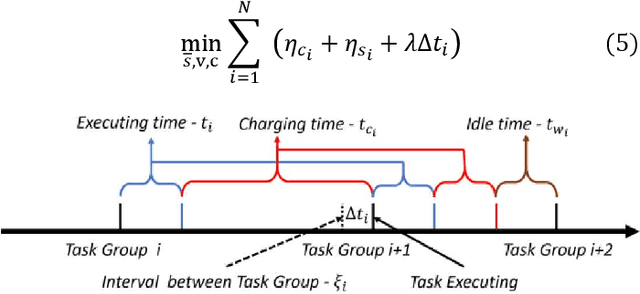
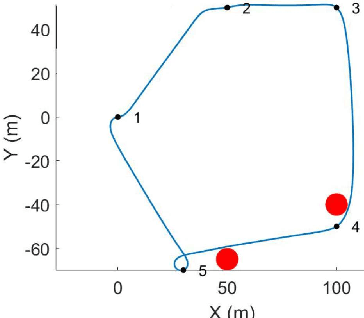
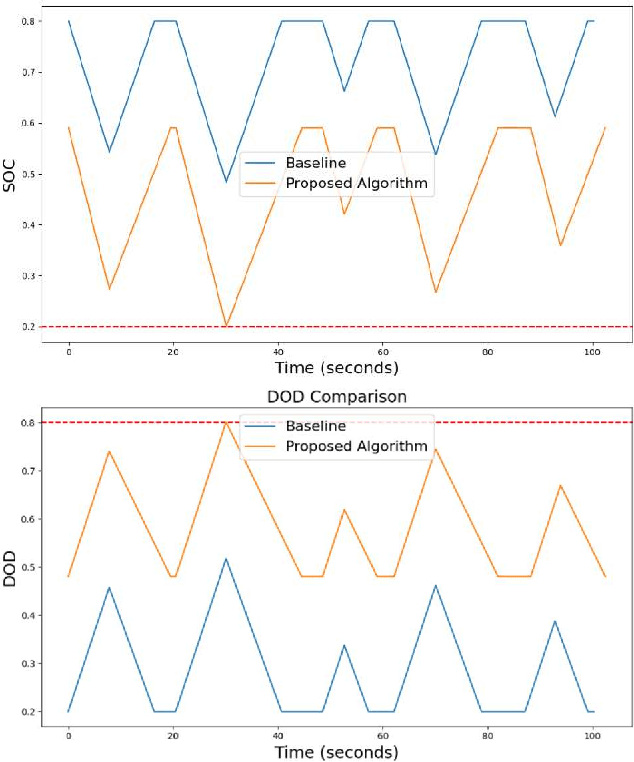
Abstract:This paper proposes an optimization framework that addresses both cycling degradation and calendar aging of batteries for autonomous mobile robot (AMR) to minimize battery degradation while ensuring task completion. A rectangle method of piecewise linear approximation is employed to linearize the bilinear optimization problem. We conduct a case study to validate the efficiency of the proposed framework in achieving an optimal path planning for AMRs while reducing battery aging.
Robust Optimal Task Planning to Maximize Battery Life
Jun 12, 2025Abstract:This paper proposes a control-oriented optimization platform for autonomous mobile robots (AMRs), focusing on extending battery life while ensuring task completion. The requirement of fast AMR task planning while maintaining minimum battery state of charge, thus maximizing the battery life, renders a bilinear optimization problem. McCormick envelop technique is proposed to linearize the bilinear term. A novel planning algorithm with relaxed constraints is also developed to handle parameter uncertainties robustly with high efficiency ensured. Simulation results are provided to demonstrate the utility of the proposed methods in reducing battery degradation while satisfying task completion requirements.
NEXT: Multi-Grained Mixture of Experts via Text-Modulation for Multi-Modal Object Re-ID
May 26, 2025



Abstract:Multi-modal object re-identification (ReID) aims to extract identity features across heterogeneous spectral modalities to enable accurate recognition and retrieval in complex real-world scenarios. However, most existing methods rely on implicit feature fusion structures, making it difficult to model fine-grained recognition strategies under varying challenging conditions. Benefiting from the powerful semantic understanding capabilities of Multi-modal Large Language Models (MLLMs), the visual appearance of an object can be effectively translated into descriptive text. In this paper, we propose a reliable multi-modal caption generation method based on attribute confidence, which significantly reduces the unknown recognition rate of MLLMs in multi-modal semantic generation and improves the quality of generated text. Additionally, we propose a novel ReID framework NEXT, the Multi-grained Mixture of Experts via Text-Modulation for Multi-modal Object Re-Identification. Specifically, we decouple the recognition problem into semantic and structural expert branches to separately capture modality-specific appearance and intrinsic structure. For semantic recognition, we propose the Text-Modulated Semantic-sampling Experts (TMSE), which leverages randomly sampled high-quality semantic texts to modulate expert-specific sampling of multi-modal features and mining intra-modality fine-grained semantic cues. Then, to recognize coarse-grained structure features, we propose the Context-Shared Structure-aware Experts (CSSE) that focuses on capturing the holistic object structure across modalities and maintains inter-modality structural consistency through a soft routing mechanism. Finally, we propose the Multi-Modal Feature Aggregation (MMFA), which adopts a unified feature fusion strategy to simply and effectively integrate semantic and structural expert outputs into the final identity representations.
ICPL-ReID: Identity-Conditional Prompt Learning for Multi-Spectral Object Re-Identification
May 23, 2025



Abstract:Multi-spectral object re-identification (ReID) brings a new perception perspective for smart city and intelligent transportation applications, effectively addressing challenges from complex illumination and adverse weather. However, complex modal differences between heterogeneous spectra pose challenges to efficiently utilizing complementary and discrepancy of spectra information. Most existing methods fuse spectral data through intricate modal interaction modules, lacking fine-grained semantic understanding of spectral information (\textit{e.g.}, text descriptions, part masks, and object keypoints). To solve this challenge, we propose a novel Identity-Conditional text Prompt Learning framework (ICPL), which exploits the powerful cross-modal alignment capability of CLIP, to unify different spectral visual features from text semantics. Specifically, we first propose the online prompt learning using learnable text prompt as the identity-level semantic center to bridge the identity semantics of different spectra in online manner. Then, in lack of concrete text descriptions, we propose the multi-spectral identity-condition module to use identity prototype as spectral identity condition to constraint prompt learning. Meanwhile, we construct the alignment loop mutually optimizing the learnable text prompt and spectral visual encoder to avoid online prompt learning disrupting the pre-trained text-image alignment distribution. In addition, to adapt to small-scale multi-spectral data and mitigate style differences between spectra, we propose multi-spectral adapter that employs a low-rank adaption method to learn spectra-specific features. Comprehensive experiments on 5 benchmarks, including RGBNT201, Market-MM, MSVR310, RGBN300, and RGBNT100, demonstrate that the proposed method outperforms the state-of-the-art methods.
SYKI-SVC: Advancing Singing Voice Conversion with Post-Processing Innovations and an Open-Source Professional Testset
Jan 06, 2025Abstract:Singing voice conversion aims to transform a source singing voice into that of a target singer while preserving the original lyrics, melody, and various vocal techniques. In this paper, we propose a high-fidelity singing voice conversion system. Our system builds upon the SVCC T02 framework and consists of three key components: a feature extractor, a voice converter, and a post-processor. The feature extractor utilizes the ContentVec and Whisper models to derive F0 contours and extract speaker-independent linguistic features from the input singing voice. The voice converter then integrates the extracted timbre, F0, and linguistic content to synthesize the target speaker's waveform. The post-processor augments high-frequency information directly from the source through simple and effective signal processing to enhance audio quality. Due to the lack of a standardized professional dataset for evaluating expressive singing conversion systems, we have created and made publicly available a specialized test set. Comparative evaluations demonstrate that our system achieves a remarkably high level of naturalness, and further analysis confirms the efficacy of our proposed system design.
PANDORA: Deep graph learning based COVID-19 infection risk level forecasting
Jun 07, 2024



Abstract:COVID-19 as a global pandemic causes a massive disruption to social stability that threatens human life and the economy. Policymakers and all elements of society must deliver measurable actions based on the pandemic's severity to minimize the detrimental impact of COVID-19. A proper forecasting system is arguably important to provide an early signal of the risk of COVID-19 infection so that the authorities are ready to protect the people from the worst. However, making a good forecasting model for infection risks in different cities or regions is not an easy task, because it has a lot of influential factors that are difficult to be identified manually. To address the current limitations, we propose a deep graph learning model, called PANDORA, to predict the infection risks of COVID-19, by considering all essential factors and integrating them into a geographical network. The framework uses geographical position relations and transportation frequency as higher-order structural properties formulated by higher-order network structures (i.e., network motifs). Moreover, four significant node attributes (i.e., multiple features of a particular area, including climate, medical condition, economy, and human mobility) are also considered. We propose three different aggregators to better aggregate node attributes and structural features, namely, Hadamard, Summation, and Connection. Experimental results over real data show that PANDORA outperforms the baseline method with higher accuracy and faster convergence speed, no matter which aggregator is chosen. We believe that PANDORA using deep graph learning provides a promising approach to get superior performance in infection risk level forecasting and help humans battle the COVID-19 crisis.
 Add to Chrome
Add to Chrome Add to Firefox
Add to Firefox Add to Edge
Add to Edge